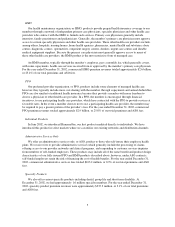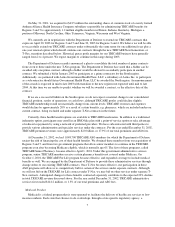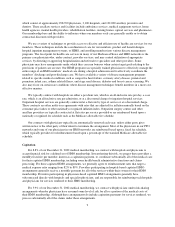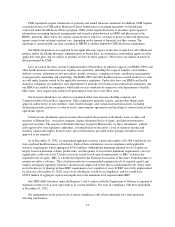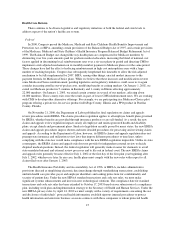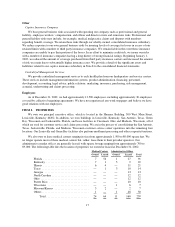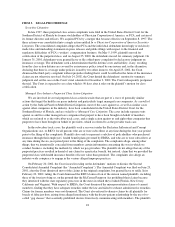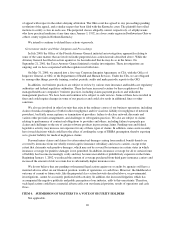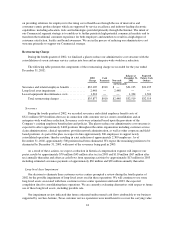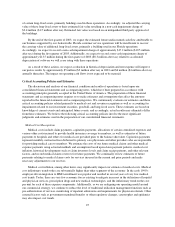Humana 2002 Annual Report Download - page 21
Download and view the complete annual report
Please find page 21 of the 2002 Humana annual report below. You can navigate through the pages in the report by either clicking on the pages listed below, or by using the keyword search tool below to find specific information within the annual report.Health Care Reform
There continue to be diverse legislative and regulatory initiatives at both the federal and state levels to
address aspects of the nation’s health care system.
Federal
In 2000, Congress passed the Medicare, Medicaid and State Childrens Health Benefits Improvement and
Protection Act, or BIPA, amending certain provisions of the Balanced Budget Act of 1997, and certain provisions
of the Medicare, Medicaid and State Children’s Health Insurance Program Balanced Budget Refinement Act of
1999. The Balanced Budget Act changed the way health plans are compensated for Medicare members by
eliminating over five years amounts paid for graduate medical education, increasing the blend of national cost
factors applied in determining local reimbursement rates over a six-year phase-in period and directing CMS to
implement a risk adjusted mechanism on its monthly member payment to Medicare plans over the same period.
These changes have had the effect of reducing reimbursement in high cost metropolitan areas with a large
number of teaching hospitals. Congress has subsequently lengthened this timetable to allow the risk adjusted
mechanism to be fully implemented by 2007. BIPA, among other things, enacted modest increases to the
payment formula for Medicare+Choice plans. While we believe that these increases and modifications restore
some Medicare+Choice reimbursement, pending legislative and regulatory initiatives could cause us to again
consider increasing enrollee out-of-pocket costs, modifying benefits or exiting markets. On January 1, 2002, we
exited our Medicare product in 5 counties in Kentucky and 1 county in Illinois affecting approximately
22,000 members. On January 1, 2003, we exited certain counties in several of our markets, affecting about
10,000 members. These county exits were the result, in part, of lower CMS reimbursement rates. We are working
with CMS to develop other alternative offerings. For example, we are participating in a Medicare+Choice pilot
program offering a private fee-for-service product in DuPage County, Illinois and a PPO product in Pinellas
County, Florida.
On November 21, 2000, the Department of Labor published its final regulation on claims and appeals
review procedures under ERISA. The claims procedure regulation applies to all employee benefit plans governed
by ERISA, whether benefits are provided through insurance products or are self-funded. As a result, the new
claims and appeals review regulation impacts nearly all employer and union-sponsored health and disability
plans, except church and government plans. Similar to legislation recently passed by many states, the new ERISA
claims and appeals procedures impose shorter and more detailed procedures for processing and reviewing claims
and appeals. According to the Department of Labor, however, its ERISA claims and appeals regulation does not
preempt state insurance and utilization review laws that impose different procedures or time lines, unless
complying with the state law would make compliance with the new ERISA regulation impossible. Unlike its state
counterparts, the ERISA claims and appeals rule does not provide for independent external review to decide
disputed medical questions. Instead, the federal regulation will generally make it easier for claimants to avoid
state-mandated internal and external review processes and to file suit in federal court. The new ERISA claims
and appeals rules generally became effective July 1, 2002 or the first day of the first plan year beginning after
July 1, 2002, whichever is later. In any case, health plans must comply with the new rules with respect to all
claims filed on or after January 1, 2003.
The Health Insurance Portability and Accountability Act of 1996, or HIPAA, includes administrative
provisions directed at simplifying electronic data interchange through standardizing transactions, establishing
uniform health care provider, payer and employer identifiers and seeking protections for confidentiality and
security of patient data. Under the new HIPAA standard transactions and code sets rules, we must make
significant systems enhancements and invest in new technological solutions. The compliance date for standard
transactions and code sets rules has been extended to October 17, 2003 based on our submission of a compliance
plan, including work plan and implementation strategy to the Secretary of Health and Human Services. Under the
new HIPAA privacy rules, by April 14, 2003 we must comply with a variety of requirements concerning the use
and disclosure of individuals’ protected health information, establish rigorous internal procedures to protect
health information and enter into business associate contracts with those companies to whom protected health
15


